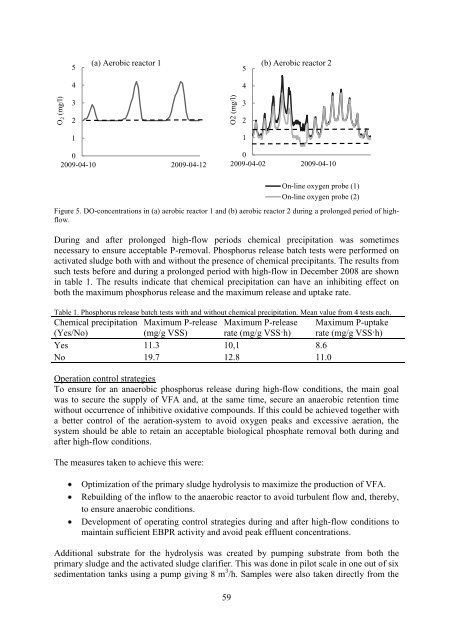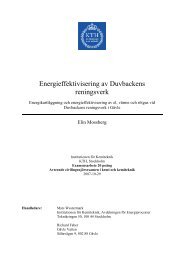Problematik vid höga flöden - Gästrike Vatten AB
Problematik vid höga flöden - Gästrike Vatten AB
Problematik vid höga flöden - Gästrike Vatten AB
Create successful ePaper yourself
Turn your PDF publications into a flip-book with our unique Google optimized e-Paper software.
O 2 (mg/l)<br />
5<br />
4<br />
3<br />
2<br />
1<br />
(a) Aerobic reactor 1<br />
0<br />
2009-04-10 06 2009-04-12 18<br />
Figure 5. DO-concentrations in (a) aerobic reactor 1 and (b) aerobic reactor 2 during a prolonged period of highflow.<br />
During and after prolonged high-flow periods chemical precipitation was sometimes<br />
necessary to ensure acceptable P-removal. Phosphorus release batch tests were performed on<br />
activated sludge both with and without the presence of chemical precipitants. The results from<br />
such tests before and during a prolonged period with high-flow in December 2008 are shown<br />
in table 1. The results indicate that chemical precipitation can have an inhibiting effect on<br />
both the maximum phosphorus release and the maximum release and uptake rate.<br />
Table 1. Phosphorus release batch tests with and without chemical precipitation. Mean value from 4 tests each.<br />
Chemical precipitation Maximum P-release Maximum P-release Maximum P-uptake<br />
(Yes/No)<br />
(mg/g VSS) rate (mg/g VSS·h) rate (mg/g VSS·h)<br />
Yes 11.3 10,1 8.6<br />
No 19.7 12.8 11.0<br />
Operation control strategies<br />
To ensure for an anaerobic phosphorus release during high-flow conditions, the main goal<br />
was to secure the supply of VFA and, at the same time, secure an anaerobic retention time<br />
without occurrence of inhibitive oxidative compounds. If this could be achieved together with<br />
a better control of the aeration-system to avoid oxygen peaks and excessive aeration, the<br />
system should be able to retain an acceptable biological phosphate removal both during and<br />
after high-flow conditions.<br />
The measures taken to achieve this were:<br />
O2 (mg/l)<br />
Optimization of the primary sludge hydrolysis to maximize the production of VFA.<br />
Rebuilding of the inflow to the anaerobic reactor to avoid turbulent flow and, thereby,<br />
to ensure anaerobic conditions.<br />
Development of operating control strategies during and after high-flow conditions to<br />
maintain sufficient EBPR activity and avoid peak effluent concentrations.<br />
Additional substrate for the hydrolysis was created by pumping substrate from both the<br />
primary sludge and the activated sludge clarifier. This was done in pilot scale in one out of six<br />
sedimentation tanks using a pump giving 8 m 3 /h. Samples were also taken directly from the<br />
59<br />
5<br />
4<br />
3<br />
2<br />
1<br />
(b) Aerobic reactor 2<br />
0<br />
2009-04-02 00 2009-04-10 08<br />
On-line oxygen probe (1)<br />
On-line oxygen probe (2)






